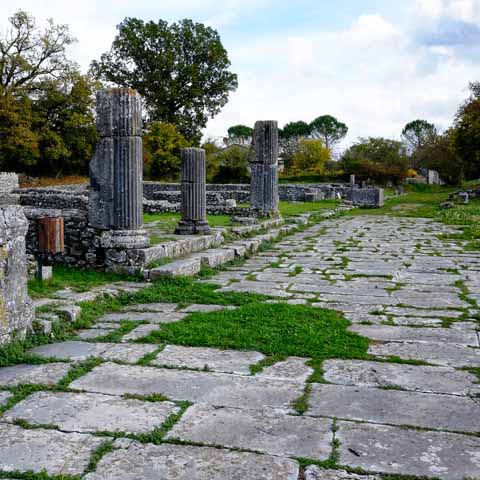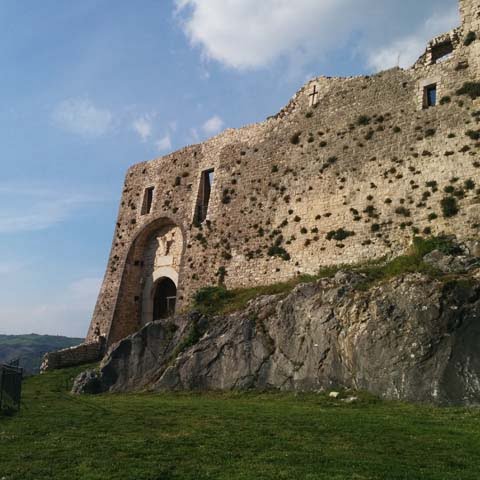Campobasso is the capital of the homonymous province and of Molise. The largest city in the region by population, Campobasso has a rather recent history and uncertain prehistory.
The city has perhaps Lombard origins and is located in the area between the Biferno and Fortore Rivers. Its old city center gathers numerous testimonies of different historical periods, including the thirteenth-century Church of San Leonardo, the fifteenth-century Monforte Castle, and the neoclassical Cathedral of the Holy Trinity.
In 2018, Campobasso was awarded the title of settlement of considerable historical interest by the Ministry of Cultural Heritage.
The city is also home to a university, a police training school, and the metropolitan Archdiocese of Campobasso-Boiano.
The origin of the name is shrouded in mystery, and there are few certainties among many hypotheses. Some historians believe the original town was divided into two villages, Campus de Prata and Campus Bassus. The former settlement would have been destroyed, and the inhabitants would have moved to the latter, giving the name to the future town.
According to other sources, the original name was Campus Vassorum, meaning the field of vassals.
One of the most plausible explanations though considers that the name is strictly related to the topographical position of the settlement, Campobasso, meaning low field.
PREHISTORY OF CAMPOBASSO
The origins of Campobasso are uncertain, and there is little evidence of which populations settled in this area for the first time. On the high ground that dominates today’s city, there was a settlement controlled by the Samnites whose traces are still preserved to these days.
This site had a defensive purpose confirmed by the discovery of the remains of the Oscan-Samnite walls, as well as the discovery, among the ruins of the Church of San Mercurio, of an Oscan inscription bearing the name Valvennius.
It is believed that this settlement has gravitated around a more important center that some historians identify with the ancient city of Aquilonia, located on Mount Vairano, between the towns of Campobasso, Baranello, and Busso.
Whether or not this is true, careful excavation campaigns brought to light numerous traces of ancient civilizations that now constitute an archaeological site.
Located at only a few miles away from Campobasso, in the municipality of Sepino, there is another important archaeological site named Atilia. Characterized by wide streets, walls, arches, gates, thermal baths, and a forum, this suggestive place attests to the passage of the Samnite and Roman civilizations in the era.
The prehistory of the territory of Campobasso is therefore inextricably linked to ancient Samnite and Roman history.
HISTORY OF CAMPOBASSO
Although Campobasso was most likely settled on the slopes of the Monforte Hill in pre-Roman times, the documented history does not include any testimonies until the end of the ninth century AD.
This period corresponds to the Lombard domination; during this era, the settlement expanded into a semi-circular area towards the base of the hill. In the following centuries, especially during the Norman period, the first nucleus became a city that was almost immediately recognized as the seat of the counts of Molise.
Towards the middle of the twelfth century, the county of Molise is cited as the largest continental state of the Norman monarchy, a fact that emphasizes the importance of the region – and subsequently of Campobasso – in the empire.
With the end of the Norman domination in the region, Molise and the entire countryside became a fief of the noble family of Monforte.
Campobasso saw the arrival of Count Nicola of Monforte in the city. The count contributed greatly to the expansion of Campobasso, which witnessed the expansion of the heart of the town from the Castle to Largo San Leonardo.
Under the orders of Nicola, the castle was rebuilt and enlarged over the remains of an ancient Norman fortress, while new edifices including a market, religious center, and baronial palace emerged.
Following the devastating destruction of the city due to the earthquake of 1456, the count delimited the city from the rest of the territory by building a defensive double wall with patrol and battlement walkways and two access gates, the Gate of San Leonardo and the Gate of Santa Cristina.
The other four gates were only built about twenty years later under the orders of Ferdinand of Aragon.
The city continued to expand under the rule of Ferdinand, who ordered the enlargement of the walls so that they could also incorporate the so-called Fondaco della Farina square. This new place became the site of a large grain market as well as the customs.
Towards the end of the fifteenth century, the fief passed into the hands of De Capoa, who consequently acquired the land from the counts of Gambatesa and Monforte.
A descendant of the De Capoa family, Isabella, became the wife of Ferrante Gonzaga, viceroy of Milan, towards the middle of the sixteenth century. This union led to a new change of power, as Campobasso passed to the prestigious Gonzaga family.
Under Gonzaga rule, Campobasso knew flourishing commerce and craft activities. People in the region started to focus on the production of iron goods, weapons, terracotta, and stone. At the same time, some people became involved in agriculture, transforming Campobasso into a wealthy territory.
The economic development was so strong that the space on the southern slope of Montebello was no longer sufficient. Despite the opposition of the nobles against the expansion, opposition mainly driven by defensive reasons, the new commercial and artisanal classes decided to cross the city walls and trace new boundaries over the following centuries.
Regarding social life, during the sixteenth century, it was majorly concentrated around three confraternities. However, the great rivalry between the Crusaders and the Trinitarians led to long disputes and bloody feuds. The former were constituted of noble families interested in military dominance. The latter were merchants interested in economic growth. Their clashes led to violent incidents triggered by the dispute over which group should take precedence in the procession for the Corpus Domini.
Finally, during Lent in 1587, the Capuchin preacher Geronimo da Sorbo succeeded in making the parties sign a peace treaty during a solemn ceremony. The document is depicted in a painting of Gianmaria Felice, a Trinitarian who witnessed the process.
This story is also linked to some struggles between Delicata Civerra and Fonzo Mastrangelo, two lovers divided by the rival groups.
Sadly, it seems that Delicata fell ill and died just days before the peace treaty was signed, while Fonzo retired to a convent as soon as he learned of his beloved’s death.
Romantic stories apart, upon the agreement, the Gonzaga gave great prestige to the city through splendid patronage.
Between the seventeenth and eighteenth centuries though, the city fell under the rule of other feudal lords including the Vitagliano, Cosso, De Marinis, and Carafa. In the meantime, the castle, which was no longer inhabited by the lords, was transformed into a prison.
In 1742, the citizens of Campobasso took the initiative of redeeming their city to the state. Through a popular collection, the locals succeeded to raise over 100,000 ducats and regained their autonomy over the territory.
The nominal ownership of the feud was conferred to a peasant family with feudal views, and the city remained feudal until 1806 when feudalism was abolished, and the Province of Molise was established.
Under the feudal domination though, Campobasso knew a strong economic development. However, two dramatic events interfered with the city’s growth: the plague and an earthquake.
These unfortunate events took a great toll on the city, which only recovered during the following century after release from the feudal yoke.
During the eighteenth century, in fact, feudality was abolished, and Campobasso was declared the provincial capital by Giuseppe Bonaparte. Campobasso became one of the most important centers in the new province of Molise and regained much of its lost prestige.
In the nineteenth century, the city entered into a new period of significant expansion, including demographic growth implemented according to the guidelines of the first urban planning established by a decree of Joachim Murat in 1815.
In the decree, Murat authorized the construction of new dwellings grouped into a new district of the city on a flat area located at the foot of the mountain.
During the following years, and thanks to the progress of the construction of the new district, the urban aspect of the city was definitively reshaped. The ancient settlement gradually lost its prestige while the economic and administrative power moved towards the new areas of Campobasso.
Here, new public buildings, tree-lined streets, squares, and parks started to concentrate on the interests of the inhabitants. For the construction of the public buildings, the city entered into a period of strong development of private urban construction during the nineteenth and twentieth centuries.
The result was a progressive growth of the city, which slowly changed its aspect until reaching its current aesthetic appeal.
During World War II, the city was involved in bloody encounters between the German troops retreating towards Abruzzo and the Allied troops. During the war, several factories and various public buildings were destroyed, including the town hall and the entire archive of the city.
Many documents attesting to the history of the city were lost during the events, but Campobasso managed to rebuild the edifices and regain its force after the end of the war.
After the war, Campobasso entered a new period of urban expansion, majorly during the 1960s and 1970s. The detachment of the region of Molise from Abruzzo accentuated, even more, the important role Campobasso has always played in the area, and the city became the main bureaucratic and administrative center of the region.
ARCHAEOLOGY IN CAMPOBASSO
Despite the rather poor testimonies of Campobasso’s prehistory, the area of the city is scattered with archaeological evidence.
Perhaps one of the most renowned open-air sites is the Roman settlement of Sepino, located at less than half an hour drive from Campobasso.
This ancient settlement is freely accessible to visitors and incorporates a wealth of Roman edifices including a basilica, a Roman theater, city walls, and gates, as well as remains of other cult buildings and private dwellings.
Under the heart of historical Campobasso lays a hypogeum, which represents one of the best-hidden realities of the ancient world.
In many areas of Campobasso, it is also possible to observe the remains of the imposing defensive structures such as the double city walls, access gates, but also a web of tunnels designed to facilitate communication.
The Roman archaeological site of Sepino also incorporates the indoor Archaeological Museum of Saepinum-Atilia that shows the entire history of the region, from the first Samnite settlement up to the first century AD.
The Museum of Campobasso Sannitico is another noteworthy place from an archaeological point of view. This museum is divided into five sections arranged in chronological order, guiding visitors through the prehistory of the city.
Other interesting places are the sanctuaries of Gildone, Campochiaro and San Giovanni in Galdi, as well as the necropolises of Gildone comprising over twenty tombs from the pre-Christian era.Travel Guides
The Molise Region of Italy
The Cities of Molise, Italy






